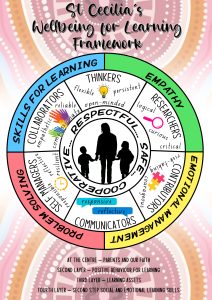Our whole school Wellbeing for Learning framework is designed to identify how we foster a comprehensive environment that supports students’ overall development, with a strong emphasis on wellbeing. The framework is structured into four interrelated layers, each playing a critical role in nurturing the growth and learning of children.
Core Layer: Family and Home Life
At the core of our framework is the family and home life. We recognise that a child’s wellbeing is deeply rooted in their home environment. Prioritising elements such as love, safety, authenticity, and supportive environments at home lays the foundation for happier and healthier children. These foundational elements ensure that children feel secure and valued, which in turn positively impacts their ability to thrive both emotionally and academically.
Second Layer: Positive Behaviour for Learning (PBL) Values
The second layer of our framework is centred around our Positive Behaviour for Learning (PBL) values. For the past ten years, our school has successfully implemented PBL, an evidence-based framework designed to cultivate a positive, safe, and supportive learning culture. PBL emphasises the development of respectful, safe, and cooperative learners. By bringing together the entire school community, PBL helps improve social, emotional, behavioural, and academic outcomes for all students, creating an environment conducive to effective learning.
Third Layer: Learning Assets
The third layer focuses on our six Learning Assets. These assets represent the essential qualities and skills that good learners need to enhance their educational journey. The six Learning Assets are:
Researchers: Encourage curiosity and the pursuit of knowledge.
Thinkers: Promote critical thinking and problem-solving skills.
Collaborators: Foster teamwork and cooperative learning.
Self-Managers: Develop self-discipline and independence.
Contributors: Inspire active participation and community involvement.
Communicators: Enhance effective communication skills across various contexts.
These assets aim to develop lifelong learners who are capable of adapting and thriving in a variety of learning situations. These are taught explicitly alongside the teaching of knowledge.
Outer Layer: Social and Emotional Learning Program (Second Step)
The outermost layer of our framework is our Social and Emotional Learning Program, Second Step. This program provides structured instruction in social and emotional learning, with specific units focused on skills for learning, empathy, emotion management and problem-solving. Implemented in a 14-20 week program each grade K-6, employs four key strategies to reinforce skill development:
Brain Builder Games: Enhance executive function, completed up to 3 times a week in class.
Weekly Theme Activities: Provide consistent thematic learning across the school communicated in fortnightly Principal’s Update.
Reinforcing Activities: Strengthen learned skills through repetition and practice.
Home Links: Connect learning with home environments, involving families in the educational process.
By explicitly teaching these social and emotional skills through the Second Step program, we aim to equip students with the tools they need to navigate both academic and personal challenges effectively.
The Wellbeing for Learning Framework is a holistic approach that integrates family and home life, PBL values, learning assets, and social and emotional learning to support and enhance the wellbeing and learning of our students. This structured yet flexible framework ensures that we address the diverse needs of our students, fostering a nurturing and effective learning environment.
